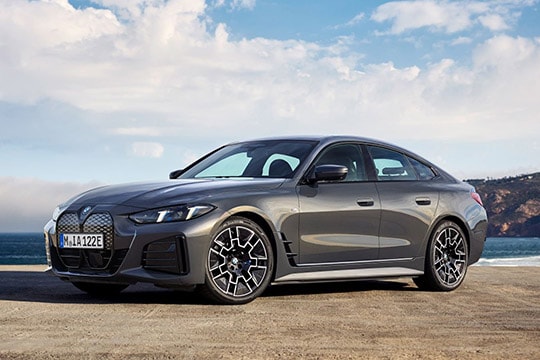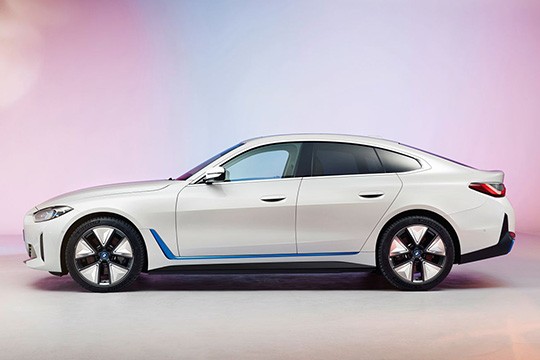BMW i4 Models/Series Timeline, Specifications & Photos
First production year: 2021
Engines: Electric
Body style: SUV (Sports Utility Vehicle)
After revealing the refreshed 4 Series in January 2024, the BMW continued the evolution with the introduction of the electric version of this nameplate, the i4, in spring 2024.
The German automaker used the same platform for the ICE and electric-powered versions of the 4 Series. That solution might have looked like a compromise, but it wasn’t. It was a clever solution to cut production costs while providing enough comfort, performance, and aspect for both versions. Even though these cars looked similar in many aspects, they were different not just from the performance point of view but also in their look. On the other hand, the interiors were almost identical, with just some specific differences. When the automaker introduced the refreshed version of the 4 Series, customers knew they’d get similar upgrades for the electric version. However, the automaker didn’t do just that; it also improved the drivetrains and provided the vehicles with more power to better stand against its main rival, the Tesla Model 3.
At the front, there were slightly better aesthetic upgrades. The classic kidney grille was surrounded by a matt chrome trim and a completely enclosed upper section. Another significant upgrade was for the headlights, which received a slimmer design and featured comma-like daytime running lights inside them. On the lower side of the bumper, the automaker offered a few options, including an M-inspired one that featured large side scoops and a broad center air intake.
From its profile, there were no significant changes besides the new 19-inch wheels’ design, available for the M package or the M440i version. BMW installed black trim around the window line and matching-color door mirrors and vents behind the front wheel arches. The 2025 BMW i4 featured new taillights that used laser diodes to illuminate optic fibers and create an intricate design. Another upgrade was for the rear diffuser, which was broader than on the pre-facelifted version of the car.
Inside, the automaker created a new dashboard that featured two screens placed one next to another under the same piece of glass to look like a continuous panel. The one fronting the driver showed the main dials and gauges for driving, while the one sitting atop the center stack was for the new iDrive 8.5 infotainment system. BMW was known for being one of the best carmakers in the world in terms of perceived material quality, and the 2025 i4 was proof of that. The dashboard, door cards, and the center console were covered in high-quality materials specific to such an upscale vehicle. At the front, depending on the grades and options, the automaker put a pair of bucket seats or a set of sports seats, while in the back, it installed a bench seat that could accommodate up to three passengers, although headroom was not something to write home about.
BMW installed a motor that drove the rear wheels for the i4 eDrive35 and the i4 eDrive40 versions, while the i4 xDrive40 came with dual motors, one for each axle. The top-of-the-range version was the i4 M50, which brought a 536 hp (543 PS) setup that drove all four wheels, which could rocket from zero to 62 mph (0-100 kph) in less than four seconds.
BMW raised the electric vehicles' standards and showed the electric-car industry how a proper sports sedan should be built when it introduced the i4 in 2021.
While Tesla was getting more attention than anyone else when it came to electric vehicles, BMW was in its lab working on a new car. Its engineers were not concerned about what other carmakers could achieve and how fast they could reach the 60-mile mark (92 kph) from standing still. With a huge experience in car building and intensive testings for the powertrain, it delivered the i4.
It used the same platform as the 4 Series to cut its costs, and it showed the same tall grille considered by some as "Bugs Bunny teeth" while others remembered that BMW wore the tall and narrow kidney-grille since the 30's. Its angular LED headlights and the wide black area in the front apron revealed an aggressive, sporty styling. From its sides, the four-door fastback styling resembled the X4 look, but in street clothes and lower ground clearance.
Inside, the carmaker made the decisive step toward the digital revolution and deleted all analog instruments inside the cabin. The instrument panel and the touch-screen for the infotainment unit shared the same long panel spread across 60% of the dashboard. But the carmaker didn't delete some physical buttons and controls.
For the powertrain, BMW charged with an all-wheel-drive electric system that provided 530 hp. Thus, it allowed the new i4 to beat the 0 to 60 mph (0-92 kph) time in less than four seconds. The carmaker promised more than 300 miles (482 km) according to the EPA tests or around 350 miles (590 km) in WLTP European tests.

